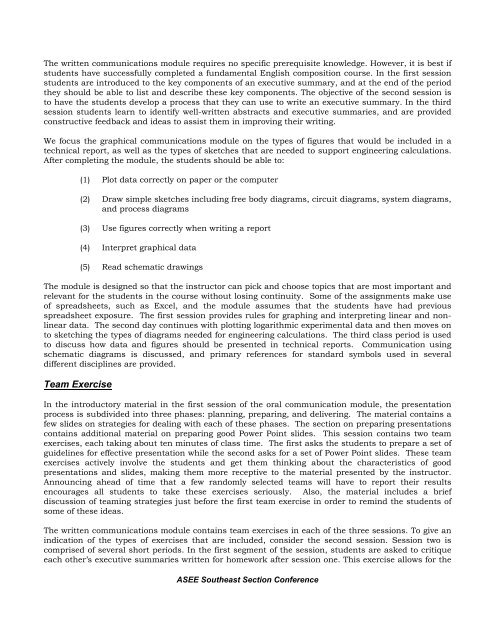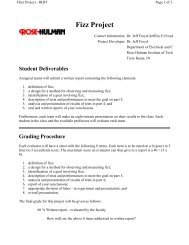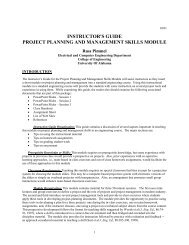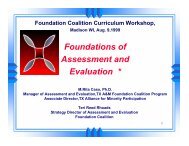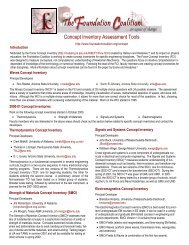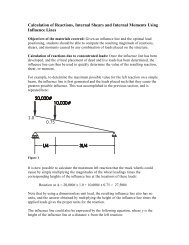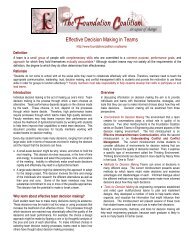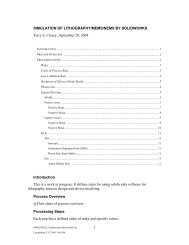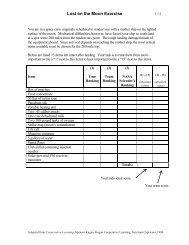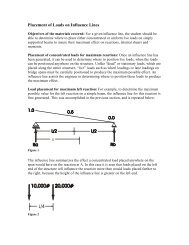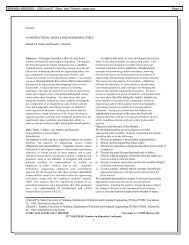Instructional Modules for Teaching Written, Oral, and Graphical ...
Instructional Modules for Teaching Written, Oral, and Graphical ...
Instructional Modules for Teaching Written, Oral, and Graphical ...
Create successful ePaper yourself
Turn your PDF publications into a flip-book with our unique Google optimized e-Paper software.
The written communications module requires no specific prerequisite knowledge. However, it is best ifstudents have successfully completed a fundamental English composition course. In the first sessionstudents are introduced to the key components of an executive summary, <strong>and</strong> at the end of the periodthey should be able to list <strong>and</strong> describe these key components. The objective of the second session isto have the students develop a process that they can use to write an executive summary. In the thirdsession students learn to identify well-written abstracts <strong>and</strong> executive summaries, <strong>and</strong> are providedconstructive feedback <strong>and</strong> ideas to assist them in improving their writing.We focus the graphical communications module on the types of figures that would be included in atechnical report, as well as the types of sketches that are needed to support engineering calculations.After completing the module, the students should be able to:(1) Plot data correctly on paper or the computer(2) Draw simple sketches including free body diagrams, circuit diagrams, system diagrams,<strong>and</strong> process diagrams(3) Use figures correctly when writing a report(4) Interpret graphical data(5) Read schematic drawingsThe module is designed so that the instructor can pick <strong>and</strong> choose topics that are most important <strong>and</strong>relevant <strong>for</strong> the students in the course without losing continuity. Some of the assignments make useof spreadsheets, such as Excel, <strong>and</strong> the module assumes that the students have had previousspreadsheet exposure. The first session provides rules <strong>for</strong> graphing <strong>and</strong> interpreting linear <strong>and</strong> nonlineardata. The second day continues with plotting logarithmic experimental data <strong>and</strong> then moves onto sketching the types of diagrams needed <strong>for</strong> engineering calculations. The third class period is usedto discuss how data <strong>and</strong> figures should be presented in technical reports. Communication usingschematic diagrams is discussed, <strong>and</strong> primary references <strong>for</strong> st<strong>and</strong>ard symbols used in severaldifferent disciplines are provided.Team ExerciseIn the introductory material in the first session of the oral communication module, the presentationprocess is subdivided into three phases: planning, preparing, <strong>and</strong> delivering. The material contains afew slides on strategies <strong>for</strong> dealing with each of these phases. The section on preparing presentationscontains additional material on preparing good Power Point slides. This session contains two teamexercises, each taking about ten minutes of class time. The first asks the students to prepare a set ofguidelines <strong>for</strong> effective presentation while the second asks <strong>for</strong> a set of Power Point slides. These teamexercises actively involve the students <strong>and</strong> get them thinking about the characteristics of goodpresentations <strong>and</strong> slides, making them more receptive to the material presented by the instructor.Announcing ahead of time that a few r<strong>and</strong>omly selected teams will have to report their resultsencourages all students to take these exercises seriously. Also, the material includes a briefdiscussion of teaming strategies just be<strong>for</strong>e the first team exercise in order to remind the students ofsome of these ideas.The written communications module contains team exercises in each of the three sessions. To give anindication of the types of exercises that are included, consider the second session. Session two iscomprised of several short periods. In the first segment of the session, students are asked to critiqueeach other’s executive summaries written <strong>for</strong> homework after session one. This exercise allows <strong>for</strong> theASEE Southeast Section Conference


